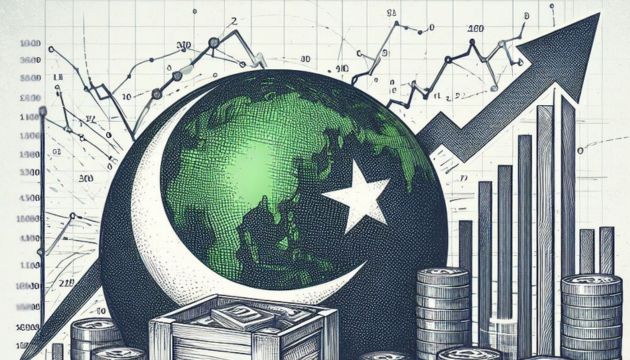By Shahzada Ahsan Ashraf
US crude remained little changed at $81.06 per barrel. Brent rose by 0.40 to $85.17 per barrel. Cotton fell by $1.45 to $97 per pound. Gold prices increased by $14 to $2169 per ounce. Coal prices rose by 10 cents to $98.5 per ton.
- [3/23, 3:26 PM] Zp: World Bank
The World Bank has approved $149.7 million in financing for Pakistan. This financing will support two projects:
- The Digital Economy Enhancement Project ($78 million), aimed at expanding digitally enabled public service delivery for citizens and firms.
- The Second Additional Financing for the Sindh Barrages Improvement Project ($71.7 million), which will enhance resilience to floods and improve the reliability, safety, and management of the three Sindh barrages.

Rupee Outlook after June:
The term “Perfect 10” was first coined in the gymnastics arena where someone flawlessly executed complex and breathtaking routines.
Last week could be summed up as a Perfect 10 for the Rupee, as everything went in its favor:
- A staff-level agreement was reached with the IMF for the 3rd review, amounting to about $1.1 billion.
- The IMF and the Government, both, were excited to start a new EFF for a 2 to 3 year period, with the speculated amount being $8 billion.
- The Current Account recorded a surplus of $128 million, significantly higher than market expectations.
- Due to the Current Account surplus, the economic team lowered its annual Current Account Deficit (CAD) from $6 billion to $2 billion and projected a foreign financing gap of $11 billion, as opposed to earlier estimates of $17.6 billion.
- The Real Effective Exchange Rate (REER) for February appreciated to 102.2, which was much lower than market expectations of around 105.
- Foreign Direct Investment (FDI) turned positive, and inflows in Roshan also increased.
- The country’s reserves increased by $239 million.
- The Sensitive Price Indicator (SPI) eased for the first time in 18 weeks to below 30%.
- Pakistan’s sovereign bonds rallied on news of the successful IMF review.
- Pakistan is all set to offer $300 million in Panda bonds.
Currency Outlook:
Despite the aforementioned positives, it is surprising that the Rupee did not strengthen more. Traders pointed out that if the State Bank of Pakistan (SBP) was not mopping up liquidity (buying dollars), the US Dollar to Pakistani Rupee exchange rate (USDPKR) would have fallen to below 275/$ for sure.
While most readers were able to sell their exports in the 1-2 month period, we are of the opinion that they should now sell around 50% of their exports in the 3-month tenor as well. This will provide them with a Rs. 10 kicker to their proceeds with little overall risk.
What Happens to the Rupee after June
While we foresee the Rupee being range-bound until the end of June, the new fiscal year may put slight pressure on the local currency, for the following reasons:
- June end is typically a month of heavy outflows.
- After attaining some stability, the government (and the IMF) will aim to boost growth, for which imports will have to increase, thereby increasing demand for dollars.
- By the end of June, we expect the REER to be around 110, and therefore some depreciation of the Rupee will be in order.
Although there will be some pressure on the Rupee, we expect it to trade around 285/$ for the Jul-Sep quarter. The wildcard in this scenario is oil prices.
Some Major Central Bank Decisions:
- The Fed holds rates and expects 3 rate cuts this year. Some astute analysts are forecasting that the Fed may not be able to deliver even one rate cut this year due to stubborn wholesale/consumer price inflation.
- The Turkish central bank stuns the market with a 500-point rate hike to 50%.
- The Bank of Japan (BOJ) ends eight years of negative interest rates.
- England and Russia keep their rates unchanged.
[3/23, 6:02 PM] Zp: Bank Alfalah has pumped Rs. 1.2 billion into its brokerage subsidiary. Why now?
Bank Alfalah Limited, one of Pakistan’s leading commercial banks, has announced an investment of Rs. 1.2 billion in its brokerage subsidiary, Alfalah CLSA Securities (Private) Limited.
The brokerage house is a sort of partnership between the Abu Dhabi Group-owned Bank Alfalah and CLSA Limited, a brokerage house based in Thailand.
The company is currently running a pure agency brokerage house offering equity brokerage, online trading, commodities trading, research, investment banking, foreign exchange services, money market, and advisory services.
Why is there a need for such a large investment?
The recent accounts of Alfalah CLSA show that the company went from making a profit of Rs. 7 million in 2022 to a loss of Rs. 1.1 billion in 2023. The onus of the poor performance lies on the brokerage house’s inability to control operating expenses. Additionally, the company utilized a short-term borrowing facility to increase its exposure margin, leading to a significant rise in finance costs.
In order to shore up the brokerage house, the bank has decided to invest a large amount. In fact, due to the loss made this year, Alfalah CLSA saw its equity turn negative. In order to shore up investor confidence and to ensure the brokerage house keeps operating, the bank is strengthening the balance sheet.
(The writer is a Former Chairman and Managing Director PIA, Former Federal Minister of industries and production)











